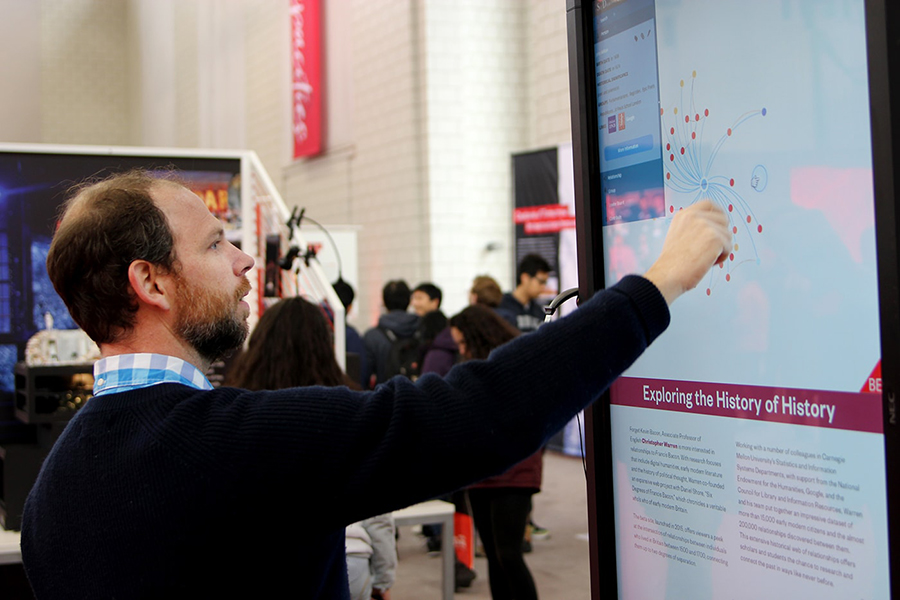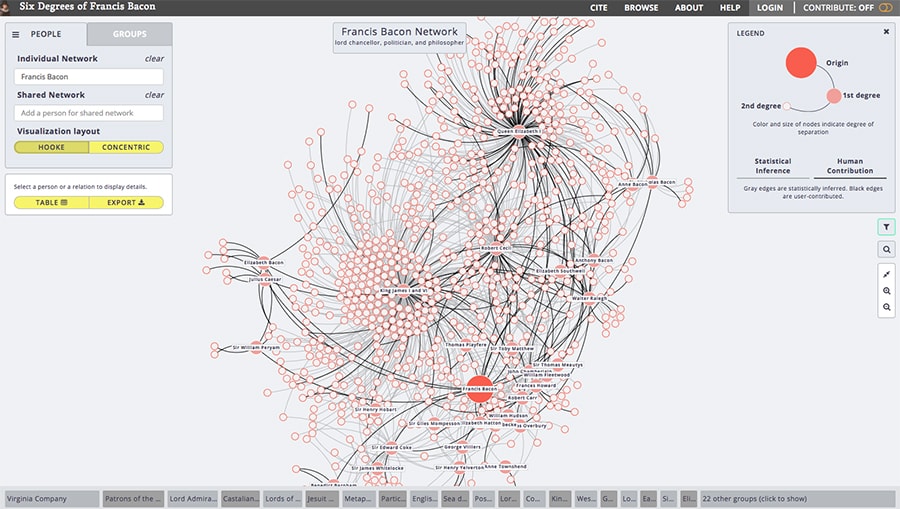
A New Look and Network for Six Degrees of Francis Bacon
By Daniel Hirsch
Gathered in Hunt Library, at the Folger Shakespeare Library, and in virtual spaces around the world watching a live-stream, early modern scholars and digital humanists joined forces earlier this month to contribute nodes to an increasingly growing digital web.
That web is Six Degrees of Francis Bacon, an online network mapping the social relationships of early modern people such as the titular Bacon as well as the likes of William Shakespeare, Isaac Newton, and numerous other well-known and virtually unknown figures. The event, an “add-a-thon” in which participants were encouraged to add new historical figures to the network, marks a growing up moment for the interactive site which associate professor of English Christopher Warren first launched in 2015.
During the event, dubbed “Re-Designing Bacon,” the site literally grew — the participation of dozens of people brought over a hundred new entries in the expanding Bacon universe — but also the event marked the launch of a new interface with several important novel features.
“The purpose of Re-Designing Bacon is to introduce the results of the recent overhaul of Six Degrees of Francis Bacon and, frankly, to put the new site through its paces before we really tighten the screws and open-source the code,” Warren said during the event.
With the launch of the new site, Warren hopes Bacon will be a tool for scholars in a variety of different ways and different fields.
For one, all the relationship and network data will be downloadable to scholars interested in early modernists. Furthermore, by making the site’s code open source available on the publishing platform Github, Bacon’s architects will enable digital humanists in other fields to create new network visualizations based on Bacon’s using their own data sets.
“Six Degrees of Francis Bacon may be about early modern people, but today isn’t for early modernists alone,” Warren said. “The challenges we’ll be working through today are challenges that a wide range of humanists are increasingly facing.”
In his remarks, Warren raised questions such as: How can network visualizations represent the uncertainty and vagueness of humanities scholarship? How can web interfaces be part of ongoing scholarship?
John Ladd, who has been at the Department of English for a year-long fellowship to help redesign Bacon’s new features, introduced the gathered groups to Bacon’s new look and capabilities.

In addition to the ability of users to submit their own entries to the network via the site’s visual interface, the Bacon’s revamp includes new ways to visualize and organize data related to groups such as the Royal Society and Elizabethan Dramatists. Also, among the many new visualization options, the new site lets users filter the network by confidence level (of the site’s administrators and algorithms) about any given relationship.
“There’s a lot more information you can see on the site at one time, so even for people who aren’t contributing, the site is more useful than it’s ever been before,” Ladd said following the event. “That’s saying something because we’ve already had a lot of people tell us it’s been very useful to their work and understanding of early modern networks.”
Sarah Reiff Conell, a PhD candidate at University of Pittsburgh who attended the add-a-thon, welcomed the new changes to Bacon’s site. She said she was eager to get to work adding people to the network.
“I think it’s awesome and I’m excited to continue the conversation,” Reiff Conell said as she navigated through the site. “The fact that we can add all these new things is great and I’m wondering who and what else might appear on the site.”
As he said in his opening remarks, Warren and the Bacon project takes “collectives quite seriously” — the site is designed so that users can see the whole social network of a person at once — so it’s only fitting that this project’s new life will be increasingly crowd-sourced.
Watch Christopher Warren and John Ladd present the new look of Six Degrees of Francis Bacon in the video below.
--
Top: Professor Christopher Warren at an interactive display of Six Degrees of Francis Bacon. Below: A screenshot from Six Degrees of Francis Bacon's new interface.